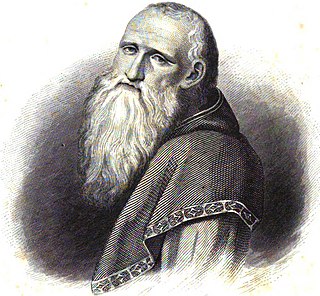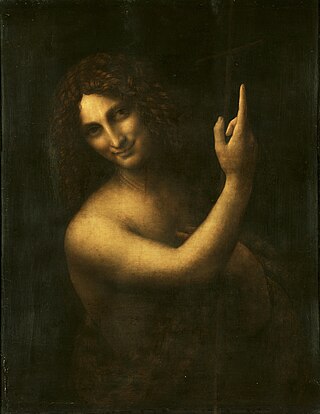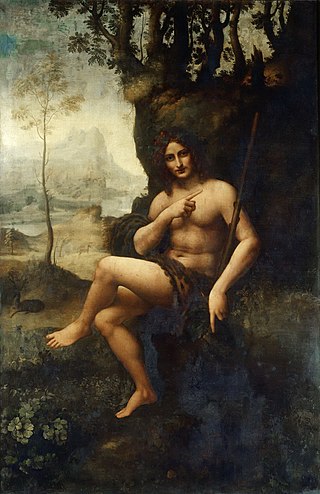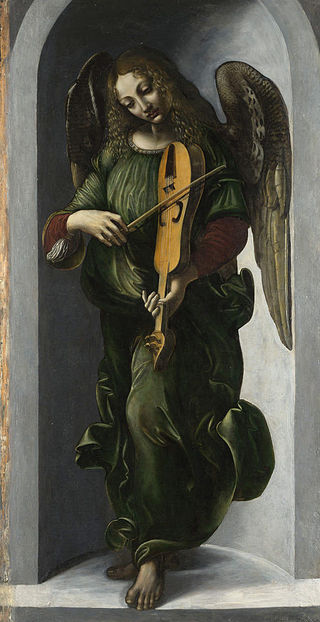
Leonardo di ser Piero da Vinci was an Italian polymath of the High Renaissance who was active as a painter, draughtsman, engineer, scientist, theorist, sculptor, and architect. While his fame initially rested on his achievements as a painter, he has also become known for his notebooks, in which he made drawings and notes on a variety of subjects, including anatomy, astronomy, botany, cartography, painting, and paleontology. Leonardo is widely regarded to have been a genius who epitomized the Renaissance humanist ideal, and his collective works comprise a contribution to later generations of artists matched only by that of his younger contemporary Michelangelo.

Il Sodoma was the name given to the Italian Renaissance painter Giovanni Antonio Bazzi. Il Sodoma painted in a manner that superimposed the High Renaissance style of early 16th-century Rome onto the traditions of the provincial Sienese school; he spent the bulk of his professional life in Siena, with two periods in Rome.

Lorenzo di Credi was an Italian Renaissance painter and sculptor best known for his paintings of religious subjects. He is most famous for having worked in the studio of Andrea del Verrocchio at the same time as the young Leonardo da Vinci.

The Virgin of the Rocks, sometimes the Madonna of the Rocks, is the name of two paintings by the Italian Renaissance artist Leonardo da Vinci, of the same subject, with a composition which is identical except for several significant details. The version generally considered the prime version, the earlier of the two, is unrestored and hangs in the Louvre in Paris. The other, which was restored between 2008 and 2010, hangs in the National Gallery, London. The works are often known as the Louvre Virgin of the Rocks and London Virgin of the Rocks respectively. The paintings are both nearly 2 metres high and are painted in oils. Both were originally painted on wooden panels, but the Louvre version has been transferred to canvas.

Bernardino Luini was a north Italian painter from Leonardo's circle during the High Renaissance. Both Luini and Giovanni Antonio Boltraffio were said to have worked with Leonardo directly; he was described as having taken "as much from Leonardo as his native roots enabled him to comprehend". Consequently, many of his works were attributed to Leonardo. He was known especially for his graceful female figures with elongated eyes, called Luinesque by Vladimir Nabokov.

The Virgin and Child with Saint Anne is an unfinished oil painting by High Renaissance artist Leonardo da Vinci, dated to c. 1501–1519. It depicts Saint Anne, her daughter the Virgin Mary and the infant Jesus. Christ is shown grappling with a sacrificial lamb symbolizing his Passion as the Virgin tries to restrain him. The painting was commissioned as the high altarpiece for the Church of Santissima Annunziata in Florence and its theme had long preoccupied Leonardo.

Saint John the Baptist is a High Renaissance oil painting on walnut wood by Leonardo da Vinci. Likely to have been completed between 1513 and 1516, it is believed to be his final painting. Its original size was 69 by 57 centimetres.

Bacchus, originally Saint John the Baptist, is a painting in the Musée du Louvre, Paris, France, based on a drawing by the Italian Renaissance artist Leonardo da Vinci. It is now attributed to Francesco Melzi, while in Leonardo's workshop. Sydney J. Freedberg assigns the drawing to Leonardo's second Milan period. Among the Lombard painters who have been suggested as possible authors are Cesare da Sesto, Marco d'Oggiono, Francesco Melzi, and Cesare Bernazzano. The painting shows a male figure with garlanded head and leopard skin, seated in an idyllic landscape. He points with his right hand off to his left, and with his left hand grasps his thyrsus and also points down to earth.

The Baptism of Christ is an oil-on-panel painting finished around 1475 in the studio of the Italian Renaissance painter Andrea del Verrocchio and generally ascribed to him and his pupil Leonardo da Vinci. Some art historians discern the hands of other members of Verrocchio's workshop in the painting as well.

Giovanni Antonio Boltraffio was an Italian painter of the High Renaissance from Lombardy, who worked in the studio of Leonardo da Vinci. Boltraffio and Bernardino Luini are the strongest artistic personalities to emerge from Leonardo's studio. According to Giorgio Vasari, he was of an aristocratic family and was born in Milan.

The Holy Infants Embracing is a lost painting attributed to Leonardo da Vinci. It represents the infant Christ embracing his cousin John the Baptist. The subject matter relates to the two paintings of the Virgin of the Rocks by Leonardo and numerous other Renaissance works by Raphael and others of the meeting of the two children on the road to Egypt while escaping the Massacre of the Innocents.

Gian Giacomo Caprotti da Oreno, better known as Salaì was an Italian artist and pupil of Leonardo da Vinci from 1490 to 1518. Salaì entered Leonardo's household at the age of ten. He created paintings under the name of Andrea Salaì. He was described as one of Leonardo's students and lifelong companion and servant and was the model for Leonardo's St. John the Baptist,Bacchus and Angelo incarnato.

La Scapigliata is an unfinished painting generally attributed to the Italian High Renaissance artist Leonardo da Vinci, and dated c. 1506–1508. Painted in oil, umber, and white lead pigments on a small poplar wood panel, its attribution remains controversial, with several experts attributing the work to a pupil of Leonardo. The painting has been admired for its captivating beauty, mysterious demeanor, and mastery of sfumato.

The Leonardeschi were the large group of artists who worked in the studio of, or under the influence of, Leonardo da Vinci. They were artists of Italian Renaissance painting, although his influence extended to many countries within Europe.

The Madonna and Child with the Infant Saint John the Baptist is a lost composition by Leonardo da Vinci. The composition is known through a handful of paintings attributed to artists in Leonardo's circle. An original underdrawing by Leonardo may be preserved in a version in a private collection in Moscow, Russia.

Holy Family with Saints Anne and John the Baptist is a c. 1530 oil on panel painting by Bernardino Luini. It was previously in the collection of cardinal Federico Borromeo, who recorded his acquisition of it in his writings and gave it to the new Biblioteca Ambrosiana in Milan in 1618, where it still hangs. The work was seized in 1796 by occupying French troops and taken to Paris, where it hung in the Louvre until being returned to Milan in 1815.

Studies of an Infant is a set of eight red chalk drawings on red ochre-prepared paper by Leonardo da Vinci, housed in the Gallerie dell'Accademia in Venice. These are representations of all or part of the body of a very young child, considered to be preparatory studies for the Infant Jesus in the oil painting The Virgin and Child with Saint Anne in the Louvre.

The Virgin and Child with Saint Anne is a cartoon said to have been created by Leonardo da Vinci as part of his "Virgin and Child with Saint Anne" project, and now considered lost. It is known from a letter written on April 3, 1501, by Fra Pietro Novellara, Isabella d'Este's envoy to the painter. For this reason, it is sometimes referred to as "Fra Pietro's cartoon". Although still hypothetical, its existence seems to be confirmed by paintings by Raffaello and Andrea del Brescianino that are said to have been made from it, as well as by various pencil studies.

The Angel musicians are two paintings created in the late 15th century to frame Leonardo da Vinci's Virgin of the Rocks. Their purpose was to decorate the side panels of the Altarpiece in the Chapel of the Immaculate Conception, created to decorate a chapel in the Church of San Francesco Grande in Milan. Separated from their original altarpiece at the very end of the 18th century, they have been in the National Gallery in London since 1898.






















